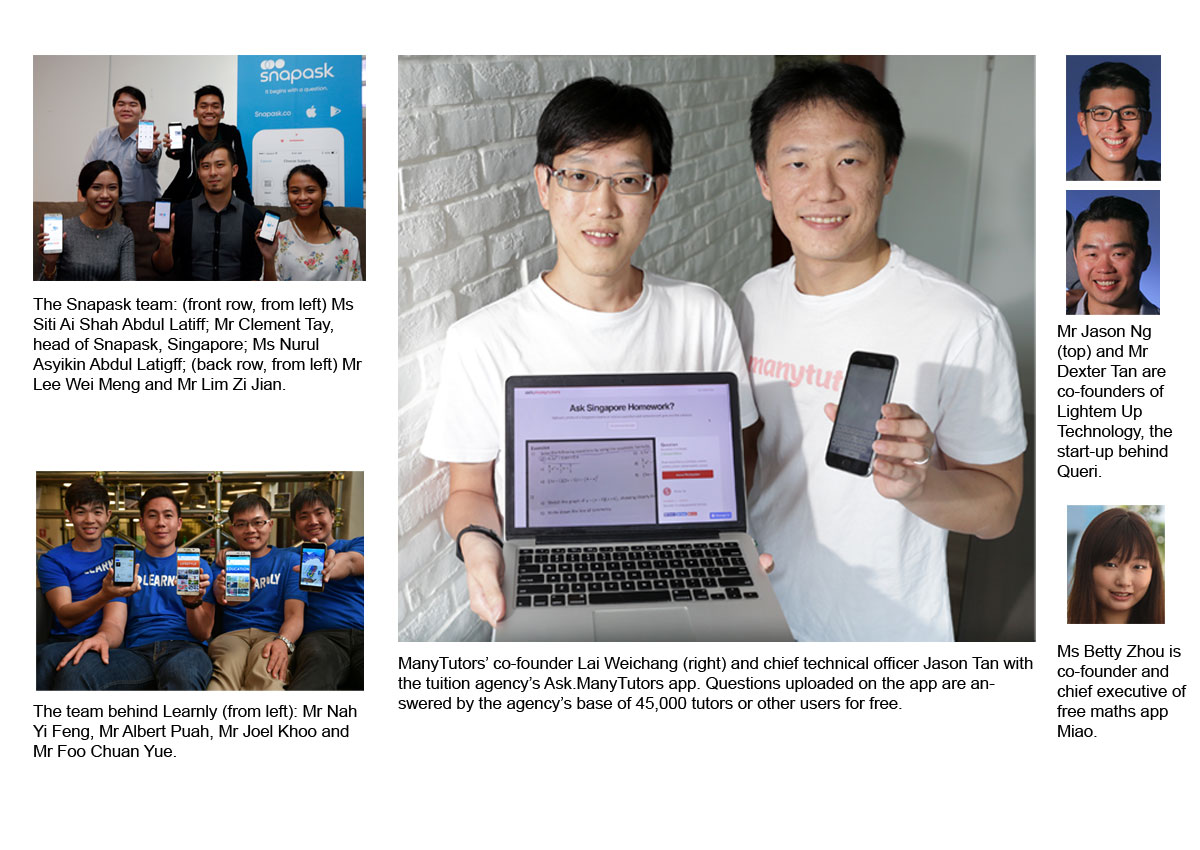They complement role of private tutors, provide 24/7 assistance to students
A few new tuition or homework help apps are trying to enlarge the billion-dollar local tuition industry through services face-to-face tutors or bricks-and-mortar centres do not provide.
These include services such as 24/7 homework assistance, automated learning tools or administrative support for private tutors.
The Straits Times spoke to the people behind five such apps which entered the Singapore market in the past year. They said they wanted to meet existing gaps in the industry, complementing the role of tutors and tuition centres.
At least three involve students taking pictures of the questions they need help on with their apps, which then source answers from tutors or other users, with different revenue models. And they seem to have gained traction.
Originally from Hong Kong,Snapask, which entered the Singapore market in November last year, counts 20 per cent of its 7,800 tutor users and 150,000 student users from here, including those on free trials.
It sells monthly packages to student users, based on the number of questions they can ask. Tutors earn a fee per question answered.
Mr Lee Wei Meng, 31, Snapask’s Singapore head of customer success, said the app solves the problem of parents’ limited time to help with their children’s school work and students’ busy days.
It positions itself as a platform where students can get their questions answered any time. Said Mr Lee: “We try as much as possible to match when our tutors are online to when demand for questions to be answered is highest.”
Local app Queri, with close to 10,000 downloads since its beta version was launched at the end of last year, helps students get answers to their questions using credits in a bidding system.
A user poses a question and sets a number of credits to be earned, while other users bid for the right to reply – and earn the credits.
Queri’s co-developer Dexter Tan, 31, said: “I know there are platforms out there where you can ask questions for free, but the harder questions tend to go unanswered. People will want to be rewarded for their time.”
Using a different tack is Miao, a free maths app which has been downloaded more than 4,500 times since its beta version was launched in October. After users snap a photo of their question, the app uses natural language processing algorithms to analyse the question and turns up information related to it and other similar practice questions. Said its co-founder and chief executive Betty Zhou, 25: “It’s not a solution solver. It’s more like a learning tool.”
In October, tuition agency ManyTutors launched its Ask.ManyTutors app where users snap images of maths or science questions to get them answered by the agency’s base of 45,000 tutors or other users for free.
Co-founder Lai Weichang, 35, said the platform showcased the agency’s pool of tutors, publicising its current business where it gets a referral fee for matching tutors to students.
At least one tutor and student matching free app, Learnly, launched early this year, is working on tutor-specific features, such as payment collection or scheduling of classes – for a fee.
Its co-founder and chief executive Joel Khoo, 27, likened the functions to a tutor productivity software: “It’s very easy for a tutor with one to three students to do all that, but not if they have 10 to 20 students. Potentially, we are enabling tutors to become super-tutors.”
The apps have given more options to students seeking homework assistance, as well as tutors looking for students.
Ms Cherynn Tan, 22, a paid tutor since she was 18, previously relied on a mix of tuition agency matches and word of mouth referrals. About five months ago, the final-year National University of Singapore chemistry undergraduate listed her tutor profile on Learnly, through which she took on six students. She said: “It directly lets me contact the students. In terms of price, there is no agency charge involved.”
Lee Yue Han, 17, a Year 5 Hwa Chong Institution student, usually turns to search engine Google if he needs instant help with a question. But he said he would consider using different apps if they proved fast and reliable.
While these apps are still growing their user base here, some already have their sights set on overseas expansion, using their Singapore link as leverage. Miao’s Ms Zhou said: “Branding helps. If it’s about education, Singapore’s reputation definitely helps.”
A look at the apps
Ask.ManyTutors
How it works: Users take pictures of their maths or science questions, and upload them into the app to be answered by the tuition agency’s pool of 45,000 tutors or other users.
Cost: Free
Queri
How it works: Users list questions under 22 categories for other users to answer.
Cost: Users buy credits (five credits for $10; 20 credits for $25) and assign them to questions as incentives for other users to answer and earn. First-time users get two free credits when they create an account.
Snapask
How it works: Students take pictures of their queries to be answered by tutors. The number of questions they can ask depends on the package they buy.
Cost: Packages are priced at $25 monthly for five questions, $55 monthly for 15 questions and $118 for an unlimited number of questions. Tutors earn $1 to $5 per question answered.
Miao
How it works: Students snap images of their maths questions (the app currently covers the A-level curriculum). The natural language processing algorithms on the app’s backend will turn up related information or similar practice questions as learning aids for students.
Cost: Free
Learnly
How it works: Students create requests for tutors or browse tutors’ profiles. Tutors list their expertise in different academic subjects or enrichment lessons. Students can look at tutors’ schedules and message them in-app.
Cost: Free

This article was first published on Dec 5, 2016.
Get a copy of The Straits Times or go to straitstimes.com for more stories.






